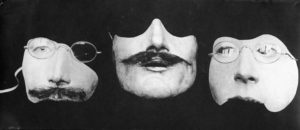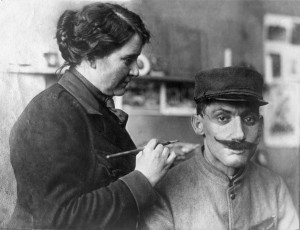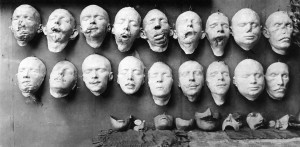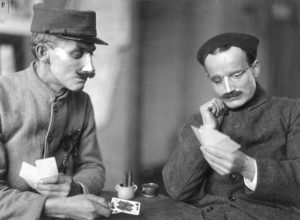World War I caused the death of millions of combatants and civilians, while countless soldiers suffered from injury and disfigurement. Perhaps the most disheartening were facial injuries, as soldiers had to not only deal with the physical loss, but also the constant psychological stress of wondering how people would react to their changed appearance. These men worried about their homecoming— how would strangers react, but more importantly how they would be treated by friends and family. Surgery and skin grafting was an option for some, but many sustained injuries that went beyond the ability of surgery to repair. These unfortunate soldiers turned to portrait masks. Pioneered by English sculptor Captain Derwent Wood, and improved upon by American sculptor Anna Coleman Ladd, portrait masks were modeled from photographs taken before the injury and were painted in oils to resemble the former features of the patient.

Captain Wood carried out experiments in a London hospital with the hope of finding a more permanent solution to the rubber and gelatin ears and noses that were being supplied to soldiers with extreme facial disfigurements. Wood’s experiments resulted in portrait masks that could be attached to a patient’s face and allow the patient to look more like his previous self. Captain Wood’s work reached America in 1917, and eventually came to the attention of fellow sculptor, Anna Coleman Ladd. Ladd felt an instant need to offer her skills to these recovering soldiers, and left for France under the sponsorship of the American Red Cross.

Ladd set up a large studio in the artists’ quarter of Paris, and there she received soldiers desperate to look like they once had. Taking a cast of the soldier’s face was the first step in the mask-making process. This mold, along with photographs of the patient prior to the injury, was then used to create a mold that resembled the patient’s previous image.

A final cast was taken from this mold, and sent to a plant where a thin copper replica was created. The copper mask was returned to Ladd to add the finishing touches. Fine copper threads were soldered onto the eyeholes to resemble eyelashes. Ladd would paint the mask while it was on the soldier so that she could achieve a flesh color as close as possible to the real skin tone. If the disfigurement included the entire mouth, she would model the lips with space to accommodate a cigarette holder. For those who desired, a moustache could be added. Anna Coleman Ladd took great care to produce masks that would allow men who gave so much for their country to return home as physically whole as possible.

